Abstract
This paper explores the application of clearance concepts to environmental toxicology. Lead, for which a clearance of about 0.5 ml/min is estimated from published data, is chosen as an example. An index for the contribution of drinking water to total exposure is developed using these concepts. For lead, this index is shown to increase with the concentration of the metal in water; it is higher for children than for adults. At the maximum contaminant level (MCL) of 10 micrograms/L proposed by the US Environmental Protection Agency (EPA), the average contribution from lead in drinking water is estimated to be 7 percent. The contribution in children is about twice as great. At and above the current MCL of 50 micrograms/L, drinking water becomes a major source of lead exposure.
Full text
PDF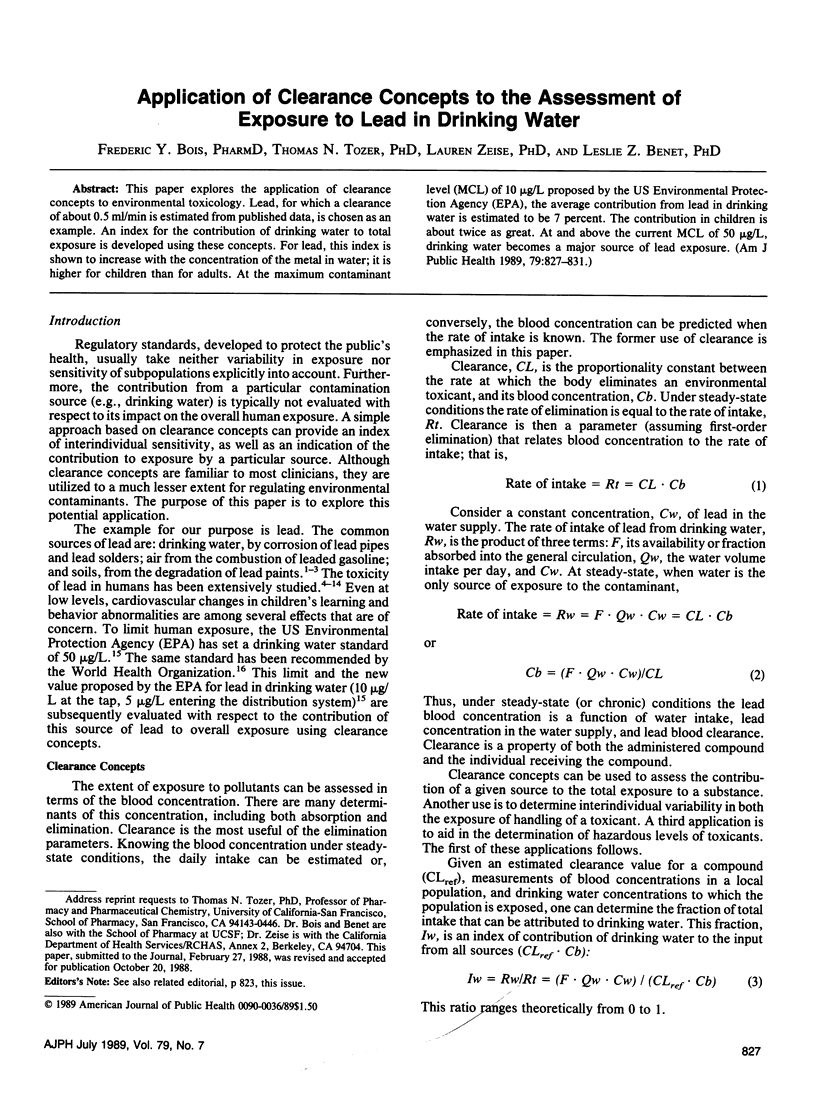
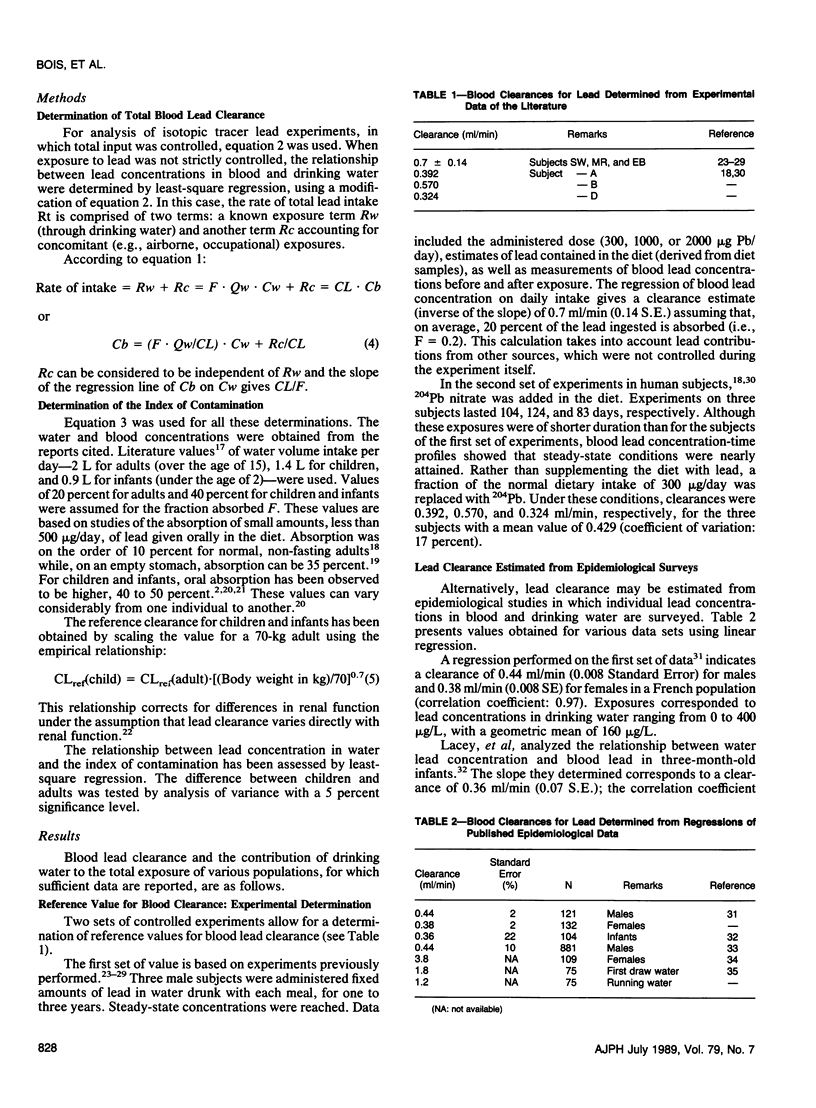
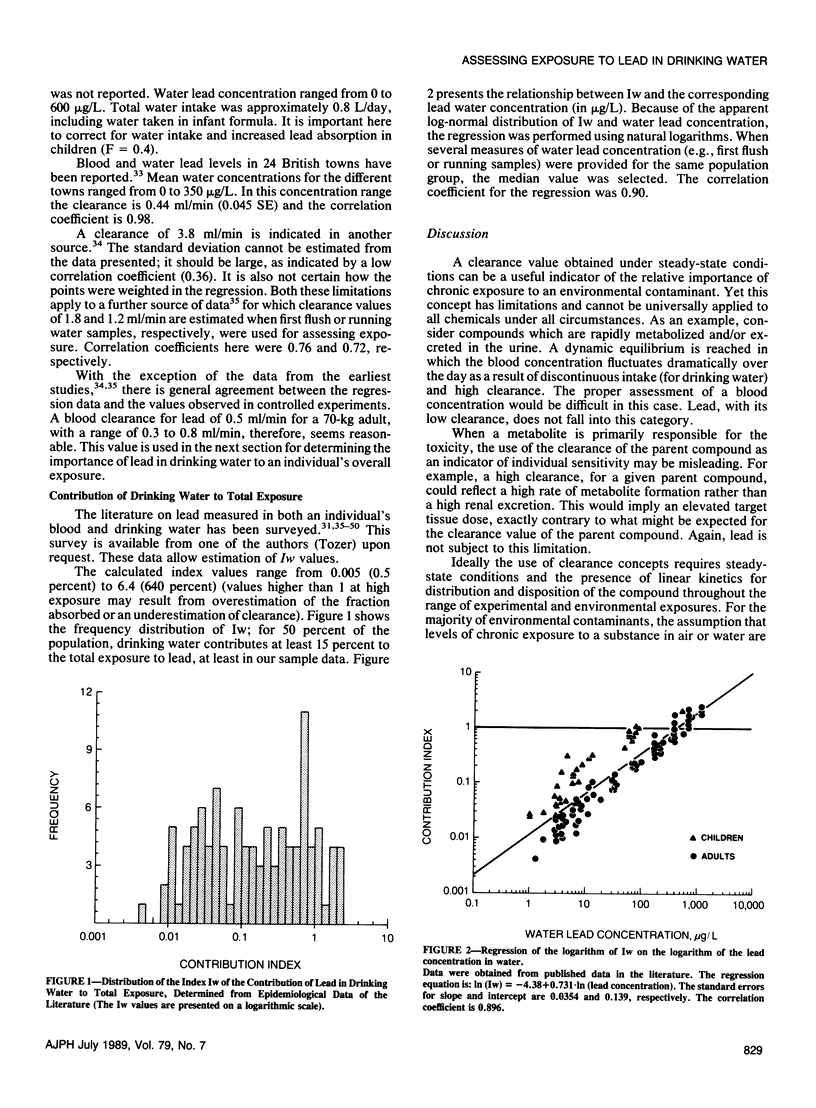
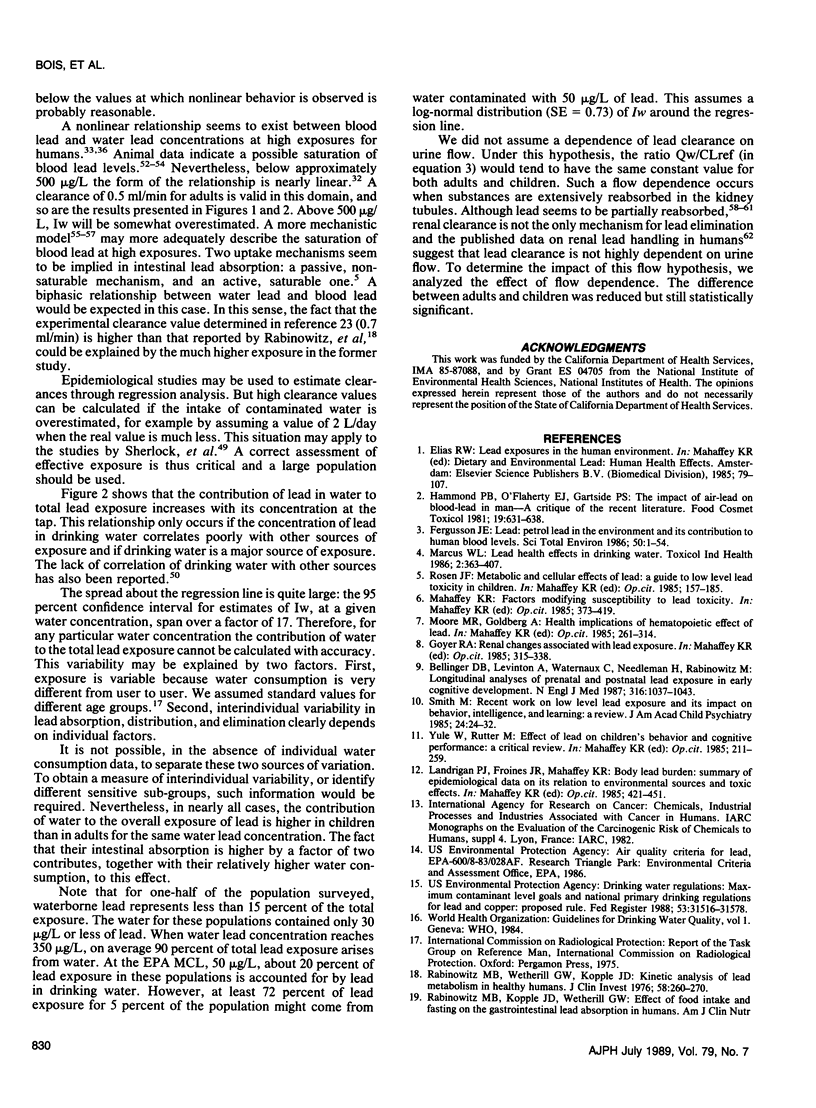
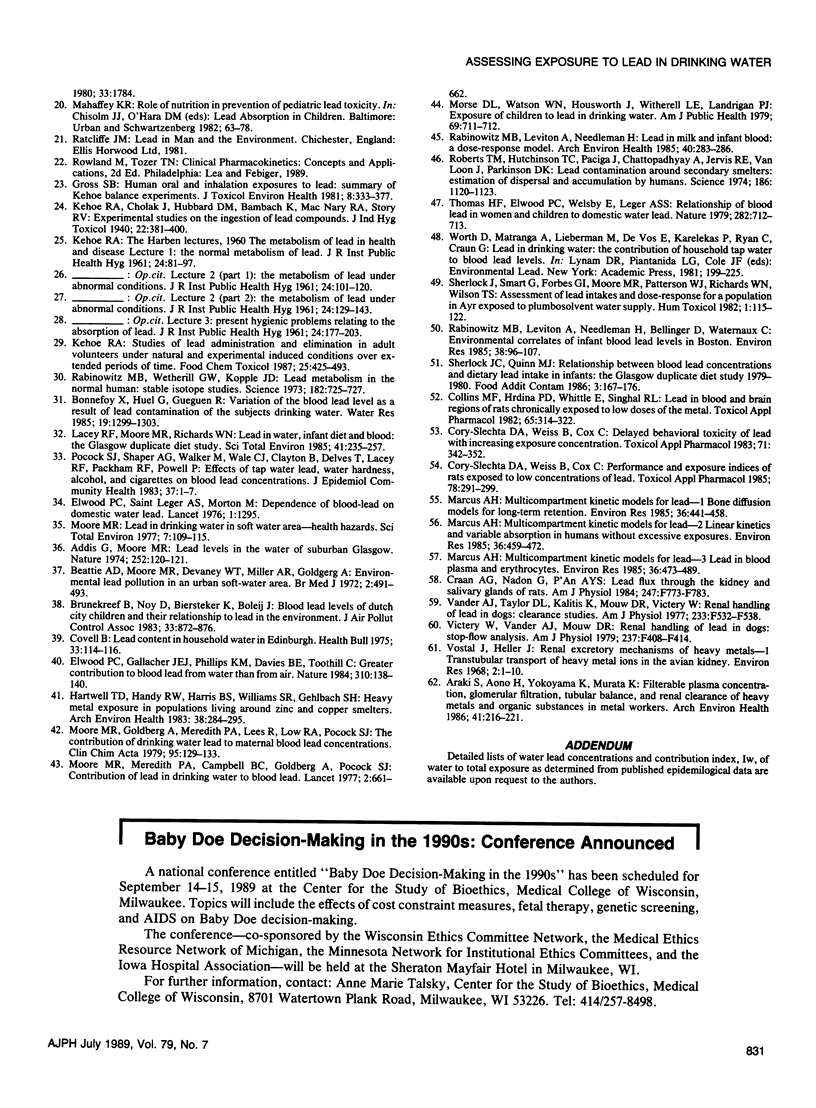
Selected References
These references are in PubMed. This may not be the complete list of references from this article.
- Araki S., Aono H., Yokoyama K., Murata K. Filterable plasma concentration, glomerular filtration, tubular balance, and renal clearance of heavy metals and organic substances in metal workers. Arch Environ Health. 1986 Jul-Aug;41(4):216–221. doi: 10.1080/00039896.1986.9938336. [DOI] [PubMed] [Google Scholar]
- Beattie A. D., Moore M. R., Devenay W. T., Miller A. R., Goldberg A. Environmental lead pollution in an urban soft-water area. Br Med J. 1972 May 27;2(5812):491–493. doi: 10.1136/bmj.2.5812.491. [DOI] [PMC free article] [PubMed] [Google Scholar]
- Bellinger D., Leviton A., Waternaux C., Needleman H., Rabinowitz M. Longitudinal analyses of prenatal and postnatal lead exposure and early cognitive development. N Engl J Med. 1987 Apr 23;316(17):1037–1043. doi: 10.1056/NEJM198704233161701. [DOI] [PubMed] [Google Scholar]
- Brunekreef B., Noy D., Biersteker K., Boleij J. Blood lead levels of Dutch city children and their relationship to lead in the environment. J Air Pollut Control Assoc. 1983 Sep;33(9):872–876. doi: 10.1080/00022470.1983.10465665. [DOI] [PubMed] [Google Scholar]
- Collins M. F., Hrdina P. D., Whittle E., Singhal R. L. Lead in blood and brain regions of rats chronically exposed to low doses of the metal. Toxicol Appl Pharmacol. 1982 Sep 15;65(2):314–322. doi: 10.1016/0041-008x(82)90014-x. [DOI] [PubMed] [Google Scholar]
- Cory-Slechta D. A., Weiss B., Cox C. Delayed behavioral toxicity of lead with increasing exposure concentration. Toxicol Appl Pharmacol. 1983 Dec;71(3):342–352. doi: 10.1016/0041-008x(83)90021-2. [DOI] [PubMed] [Google Scholar]
- Cory-Slechta D. A., Weiss B., Cox C. Performance and exposure indices of rats exposed to low concentrations of lead. Toxicol Appl Pharmacol. 1985 Apr;78(2):291–299. doi: 10.1016/0041-008x(85)90292-3. [DOI] [PubMed] [Google Scholar]
- Covell B. Lead content in household water in Edinburgh. Health Bull (Edinb) 1975 May;33(3):114–116. [PubMed] [Google Scholar]
- Craan A. G., Nadon G., P'an A. Y. Lead flux through the kidney and salivary glands of rats. Am J Physiol. 1984 Nov;247(5 Pt 2):F773–F783. doi: 10.1152/ajprenal.1984.247.5.F773. [DOI] [PubMed] [Google Scholar]
- Elwood P. C., Gallacher J. E., Phillips K. M., Davies B. E., Toothill C. Greater contribution to blood lead from water than from air. Nature. 1984 Jul 12;310(5973):138–140. doi: 10.1038/310138a0. [DOI] [PubMed] [Google Scholar]
- Elwood P. C., St Leger A. S., Morton M. Dependence of blood-lead on domestic water lead. Lancet. 1976 Jun 12;1(7972):1295–1295. doi: 10.1016/s0140-6736(76)91763-3. [DOI] [PubMed] [Google Scholar]
- Fergusson J. E. Lead: petrol lead in the environment and its contribution to human blood lead levels. Sci Total Environ. 1986 Apr;50:1–54. doi: 10.1016/0048-9697(86)90350-5. [DOI] [PubMed] [Google Scholar]
- Gross S. B. Human oral and inhalation exposures to lead: summary of Kehoe balance experiments. J Toxicol Environ Health. 1981 Sep;8(3):333–377. doi: 10.1080/15287398109530075. [DOI] [PubMed] [Google Scholar]
- Hammond P. B., O'Flaherty E. J., Gartside P. S. The impact of air-lead on blood-lead in man--a critique of the recent literature. Food Cosmet Toxicol. 1981 Oct;19(5):631–638. doi: 10.1016/0015-6264(81)90515-0. [DOI] [PubMed] [Google Scholar]
- Hartwell T. D., Handy R. W., Harris B. S., Williams S. R., Gehlbach S. H. Heavy metal exposure in populations living around zinc and copper smelters. Arch Environ Health. 1983 Sep-Oct;38(5):284–295. doi: 10.1080/00039896.1983.10544008. [DOI] [PubMed] [Google Scholar]
- Lacey R. F., Moore M. R., Richards W. N. Lead in water, infant diet and blood: the Glasgow Duplicate Diet Study. Sci Total Environ. 1985 Mar 1;41(3):235–257. doi: 10.1016/0048-9697(85)90144-5. [DOI] [PubMed] [Google Scholar]
- Marcus A. H. Multicompartment kinetic model for lead. III. Lead in blood plasma and erythrocytes. Environ Res. 1985 Apr;36(2):473–489. doi: 10.1016/0013-9351(85)90039-8. [DOI] [PubMed] [Google Scholar]
- Marcus A. H. Multicompartment kinetic models for lead. I. Bone diffusion models for long-term retention. Environ Res. 1985 Apr;36(2):441–458. doi: 10.1016/0013-9351(85)90037-4. [DOI] [PubMed] [Google Scholar]
- Marcus A. H. Multicompartment kinetic models for lead. II. Linear kinetics and variable absorption in humans without excessive lead exposures. Environ Res. 1985 Apr;36(2):459–472. doi: 10.1016/0013-9351(85)90038-6. [DOI] [PubMed] [Google Scholar]
- Marcus W. L. Lead health effects in drinking water. Toxicol Ind Health. 1986 Dec;2(4):363–407. doi: 10.1177/074823378600200403. [DOI] [PubMed] [Google Scholar]
- Moore M. R., Goldberg A., Meredith P. A., Lees R., Low R. A., Pocock S. J. The contribution of drinking water lead to maternal blood lead concentrations. Clin Chim Acta. 1979 Jul 2;95(1):129–133. doi: 10.1016/0009-8981(79)90345-0. [DOI] [PubMed] [Google Scholar]
- Moore M. R. Lead in drinking water in soft water areas--health hazards. Sci Total Environ. 1977 Mar;7(2):109–115. doi: 10.1016/0048-9697(77)90002-x. [DOI] [PubMed] [Google Scholar]
- Moore M. R., Meredith P. A., Campbell B. C., Goldberg A., Pocock S. J. [Contribution of lead in drinking water to blood-lead]. Lancet. 1977 Sep 24;2(8039):661–662. doi: 10.1016/s0140-6736(77)92528-4. [DOI] [PubMed] [Google Scholar]
- Morse D. L., Watson W. N., Housworth J., Witherell L. E., Landrigan P. J. Exposure of children to lead in drinking water. Am J Public Health. 1979 Jul;69(7):711–712. doi: 10.2105/ajph.69.7.711. [DOI] [PMC free article] [PubMed] [Google Scholar]
- Pocock S. J., Shaper A. G., Walker M., Wale C. J., Clayton B., Delves T., Lacey R. F., Packham R. F., Powell P. Effects of tap water lead, water hardness, alcohol, and cigarettes on blood lead concentrations. J Epidemiol Community Health. 1983 Mar;37(1):1–7. doi: 10.1136/jech.37.1.1. [DOI] [PMC free article] [PubMed] [Google Scholar]
- Rabinowitz M. B., Wetherill G. W., Kopple J. D. Kinetic analysis of lead metabolism in healthy humans. J Clin Invest. 1976 Aug;58(2):260–270. doi: 10.1172/JCI108467. [DOI] [PMC free article] [PubMed] [Google Scholar]
- Rabinowitz M. B., Wetherill G. W., Kopple J. D. Lead metabolism in the normal human: stable isotope studies. Science. 1973 Nov 16;182(4113):725–727. doi: 10.1126/science.182.4113.725. [DOI] [PubMed] [Google Scholar]
- Rabinowitz M., Leviton A., Needleman H., Bellinger D., Waternaux C. Environmental correlates of infant blood lead levels in Boston. Environ Res. 1985 Oct;38(1):96–107. doi: 10.1016/0013-9351(85)90075-1. [DOI] [PubMed] [Google Scholar]
- Rabinowitz M., Leviton A., Needleman H. Lead in milk and infant blood: a dose-response model. Arch Environ Health. 1985 Sep-Oct;40(5):283–286. doi: 10.1080/00039896.1985.10545933. [DOI] [PubMed] [Google Scholar]
- Roberts T. M., Hutchinson T. C., Paciga J., Chattopadhyay A., Jervis R. E., VanLoon J., Parkinson D. K. Lead contamination around secondary smelters: estimation of dispersal and accumulation by humans. Science. 1974 Dec 20;186(4169):1120–1123. doi: 10.1126/science.186.4169.1120. [DOI] [PubMed] [Google Scholar]
- Sherlock J. C., Quinn M. J. Relationship between blood lead concentrations and dietary lead intake in infants: the Glasgow Duplicate Diet Study 1979-1980. Food Addit Contam. 1986 Apr-Jun;3(2):167–176. doi: 10.1080/02652038609373579. [DOI] [PubMed] [Google Scholar]
- Sherlock J., Smart G., Forbes G. I., Moore M. R., Patterson W. J., Richards W. N., Wilson T. S. Assessment of lead intakes and dose-response for a population in Ayr exposed to a plumbosolvent water supply. Hum Toxicol. 1982 Mar;1(2):115–122. doi: 10.1177/096032718200100203. [DOI] [PubMed] [Google Scholar]
- Smith M. Recent work on low level lead exposure and its impact on behavior, intelligence, and learning: a review. J Am Acad Child Psychiatry. 1985 Jan;24(1):24–32. doi: 10.1016/s0002-7138(09)60406-4. [DOI] [PubMed] [Google Scholar]
- Thomas H. F., Elwood P. C., Welsby E., St Leger A. S. Relationship of blood lead in women and children to domestic water lead. Nature. 1979 Dec 13;282(5740):712–713. doi: 10.1038/282712a0. [DOI] [PubMed] [Google Scholar]
- Vander A. J., Taylor D. L., Kalitis K., Mouw D. R., Victery W. Renal handling of lead in dogs: clearance studies. Am J Physiol. 1977 Dec;233(6):F532–F538. doi: 10.1152/ajprenal.1977.233.6.F532. [DOI] [PubMed] [Google Scholar]
- Victery W., Vander A. J., Mouw D. R. Renal handling of lead in dogs: stop-flow analysis. Am J Physiol. 1979 Nov;237(5):F408–F414. doi: 10.1152/ajprenal.1979.237.5.F408. [DOI] [PubMed] [Google Scholar]
- Vostál J., Heller J. Renal excretory mechanisms of heavy metals. I. Transtubular transport of heavy metal ions in the avian kidney. Environ Res. 1968 Sep;2(1):1–10. doi: 10.1016/0013-9351(68)90001-7. [DOI] [PubMed] [Google Scholar]


